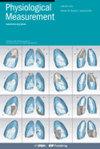Assessment of alternative metrics in the application of infrared thermography to detect muscle damage in sports.
IF 2.3
4区 医学
Q3 BIOPHYSICS
引用次数: 0
Abstract
The association between muscle damage and skin temperature is controversial. We hypothesize that including metrics that are more sensitive to individual responses by considering variability and regions representative of higher temperature could influence skin temperature outcomes. Here, the objective of the study was to determine whether using alternative metrics (TMAX, entropy, and pixelgraphy) leads to different results than mean, maximum, minimum, and standard deviation skin temperature when addressing muscle damage using infrared thermography. Approach: Thermal images from four previous investigations measuring skin temperature before and after muscle damage in the anterior thigh and the posterior lower leg were used. The TMAX, entropy, and pixelgraphy (percentage of pixels above 33ºC) metrics were applied. Main results: On 48h after running a marathon or half-marathon, no differences were found in skin temperature when applying any metric. Mean, minimum, maximum, TMAX, and pixelgraphy were lower 48h after than at basal condition following quadriceps muscle damage (p<0.05). Maximum skin temperature and pixelgraphy were lower 48h after than the basal condition following muscle damage to the triceps sural (p<0.05). Overall, TMAX strongly correlated with mean (r=0.85) and maximum temperatures (r=0.99) and moderately with minimum (r=0.66) and pixelgraphy parameter (r=0.64). Entropy strongly correlates with standard deviation (r=0.94) and inversely moderately with minimum temperature (r=-0.53). The pixelgraphy moderately correlated with mean (r=0.68), maximum (r=0.62), minimum (r=0.58), and TMAX (r=0.64). Significance: Using alternative metrics does not change skin temperature outcomes following muscle damage of lower extremity muscle groups.评估应用红外热成像技术检测运动中肌肉损伤的替代指标。
肌肉损伤与皮肤温度之间的关联存在争议。我们假设,通过考虑变异性和代表较高温度的区域,纳入对个体反应更敏感的指标,可能会影响皮肤温度结果。本研究的目的是确定在使用红外热成像技术处理肌肉损伤时,使用替代指标(TMAX、熵和像素图)是否会导致与平均、最大、最小和标准偏差皮肤温度不同的结果:使用之前四项研究中的热图像,测量大腿前侧和小腿后侧肌肉损伤前后的皮肤温度。主要结果:在跑完马拉松或半程马拉松 48 小时后,采用任何指标测量的皮肤温度均无差异。股四头肌损伤后 48 小时后的平均温度、最低温度、最高温度、TMAX 和像素图均低于基础状态(P<0.05)。肱三头肌损伤后 48 小时后的最高皮肤温度和像素图均低于基础状态(P<0.05)。总体而言,TMAX 与平均温度(r=0.85)和最高温度(r=0.99)密切相关,与最低温度(r=0.66)和像素图参数(r=0.64)适度相关。熵与标准偏差(r=0.94)密切相关,与最低温度(r=-0.53)成反比。像素图与平均值(r=0.68)、最高值(r=0.62)、最低值(r=0.58)和 TMAX(r=0.64)呈中度相关:使用替代指标不会改变下肢肌群肌肉损伤后的皮肤温度结果。
本文章由计算机程序翻译,如有差异,请以英文原文为准。
求助全文
约1分钟内获得全文
求助全文
来源期刊

Physiological measurement
生物-工程:生物医学
CiteScore
5.50
自引率
9.40%
发文量
124
审稿时长
3 months
期刊介绍:
Physiological Measurement publishes papers about the quantitative assessment and visualization of physiological function in clinical research and practice, with an emphasis on the development of new methods of measurement and their validation.
Papers are published on topics including:
applied physiology in illness and health
electrical bioimpedance, optical and acoustic measurement techniques
advanced methods of time series and other data analysis
biomedical and clinical engineering
in-patient and ambulatory monitoring
point-of-care technologies
novel clinical measurements of cardiovascular, neurological, and musculoskeletal systems.
measurements in molecular, cellular and organ physiology and electrophysiology
physiological modeling and simulation
novel biomedical sensors, instruments, devices and systems
measurement standards and guidelines.
 求助内容:
求助内容: 应助结果提醒方式:
应助结果提醒方式:


